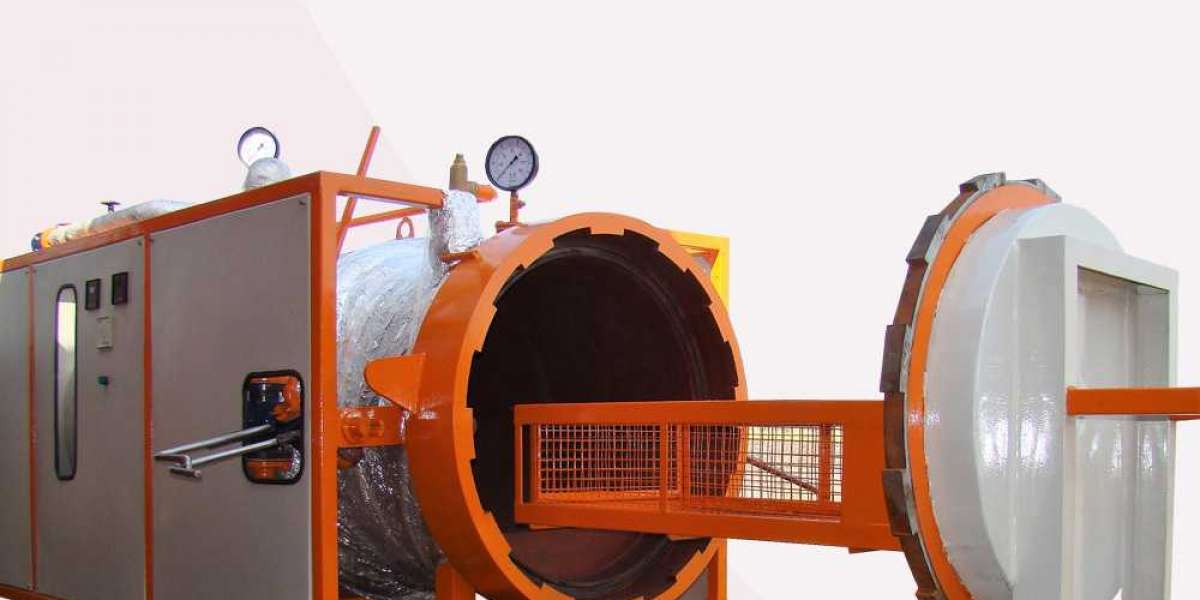What is a Steam Dewax Autoclave?
A steam dewax autoclave is a specialized pressure vessel designed to remove wax patterns from ceramic shells during the investment casting process. In investment casting, a wax pattern—essentially a replica of the final metal part—is coated with a ceramic slurry to form a hard, heat-resistant shell. The wax must then be removed to create a cavity for molten metal. Steam dewax autoclaves use high-pressure steam to melt and extract the wax, leaving the ceramic shell intact and ready for firing and metal pouring. The process involves rapidly pressurizing the autoclave with steam, typically to 6–10 bar (85–145 psi) in just a few seconds, and heating the environment to around 330°F (165°C). This rapid heat transfer melts the wax at the shell-wax interface, allowing it to flow out or be absorbed into the ceramic's primary coat, thus preventing shell cracking due to wax expansion.
For More Information: https://www.ic-machines.com/steam-dewax-autoclave/
How Does a Steam Dewax Autoclave Work?
The operation of a steam dewax autoclave is a carefully orchestrated sequence designed to protect the fragile ceramic shell while efficiently removing the wax. Here's a step-by-step overview:
Loading the Shells: Ceramic shells containing wax patterns are loaded into the autoclave. Speed is critical during this phase to minimize the time the shells are exposed to ambient conditions, which could weaken them.
Purging Air: To enhance efficiency, some advanced autoclaves purge air from the chamber before introducing steam. This minimizes the insulating effect of compressed air, which can hinder heat transfer to the wax. By reducing air presence, the autoclave can operate at lower temperatures and pressures, improving energy efficiency and reducing shell stress.
Rapid Steam Pressurization: Steam is injected quickly—often reaching 6 bar in 2–4 seconds—to deliver intense heat to the shell's surface. This rapid pressurization ensures that the wax at the shell-wax interface melts almost instantly, creating a gap that allows the remaining wax to expand without exerting excessive pressure on the shell.
Dwell Time: After pressurization, the autoclave maintains pressure and temperature for 15–20 minutes, allowing the wax to fully melt and flow out. Controlled depressurization follows at a rate of 15–30 psi per minute to prevent shell cracking due to rapid pressure changes.
Wax Collection: The melted wax is collected in a recovery tank, where it can be reclaimed for reuse, reducing waste and environmental impact compared to other methods like flash firing.
Shell Removal: Once the cycle is complete, the dewaxed shells are removed, inspected, and prepared for firing, which strengthens them for metal casting.
Advantages of Steam Dewax Autoclaves
Steam dewax autoclaves offer several benefits that make them the preferred choice for many foundries:
Precision and Shell Integrity: The rapid steam delivery minimizes thermal stress on the ceramic shell, reducing the risk of microcracks that could compromise the final casting. The controlled environment ensures consistent results.
Efficiency and Speed: Autoclaves achieve pressurization in seconds, significantly faster than traditional oven-based methods. This speed enhances throughput and reduces production bottlenecks.
Wax Reclamation: Unlike flash firing, which burns off wax and produces emissions, autoclaves allow for wax recovery, making the process more sustainable and cost-effective.
Automation and Safety: Modern autoclaves, such as those from ASC Process Systems and Akarmak, feature advanced PLC control systems, user-friendly interfaces, and safety interlocks, ensuring operator safety and process reliability.
Versatility: Autoclaves can handle a wide range of shell sizes and wax types, offering flexibility for various casting applications, from aerospace components to medical implants.
Best Practices for Optimal Dewaxing
To maximize the effectiveness of a steam dewax autoclave, foundries should adhere to the following best practices:
Optimize Steam Delivery: Aim for rapid pressurization (6 bar in 2–3 seconds) to ensure quick wax melting. Maintain pressure recovery at 8–9 bar for consistent heat transfer. Slow depressurization is equally critical to avoid shell damage from rapid pressure drops.
Purge Air Before Steaming: Use autoclaves with air-purging capabilities to enhance heat transfer efficiency and reduce the required operating pressure and temperature.
Maintain Equipment: Regular inspection of seals, doors, and safety systems is essential to prevent heat loss and ensure reliable operation. Running dummy cycles before the first batch helps the autoclave reach optimal conditions.
Shell Design Considerations: Ensure the ceramic shell has adequate permeability and strength. Adding polymers to the prime slurry can enhance flexibility, allowing the shell to absorb wax expansion without cracking. Backup coats should balance thickness for strength with porosity for steam penetration.
Wax Selection: Choose waxes with appropriate thermal expansion, viscosity, and melting points. Filled waxes with additives like polystyrene or terephthalic acid can improve dimensional stability but may increase viscosity, requiring careful management during dewaxing.
Challenges and Considerations
While steam dewax autoclaves are highly effective, they are not without challenges. The high-pressure environment requires robust safety protocols, as autoclaves are pressure vessels with fast-operating doors. Mandatory safety interlocks and regular maintenance are non-negotiable to ensure operator safety. Additionally, the initial investment in a fully integrated autoclave system can be significant, although the long-term benefits of wax reclamation and reduced shell cracking often justify the cost.
Another consideration is the balance between shell thickness and permeability. Thicker shells provide greater mechanical strength but require more steam energy, which can increase operating costs. Foundries must carefully design their shell systems to optimize performance.
The Future of Steam Dewax Autoclaves
As investment casting continues to evolve, so do steam dewax autoclaves. Innovations in automation, such as Akarmak's PLC-controlled systems and ASC's proportional vent valve systems, are making the process more precise and user-friendly. Research into wax behavior, such as studies conducted under the FOCAST program at Birmingham University, is also informing better wax formulations and process parameters, further reducing shell cracking and improving efficiency.
Moreover, the push for sustainability is driving interest in autoclaves over flash firing, as they produce fewer emissions and allow for wax reuse. As industries like aerospace and medical device manufacturing demand ever-higher precision, steam dewax autoclaves will remain a vital tool in delivering flawless castings.
Conclusion
Steam dewax autoclaves are a linchpin of the investment casting process, combining speed, precision, and sustainability to produce high-quality ceramic shells. By rapidly delivering steam to melt wax patterns, these systems minimize shell damage and enable efficient production. With proper maintenance, optimized shell and wax design, and adherence to best practices, foundries can leverage autoclaves to achieve superior results. As technology advances, steam dewax autoclaves will continue to play a pivotal role in shaping the future of investment casting, ensuring that this ancient craft meets the demands of modern industry.








